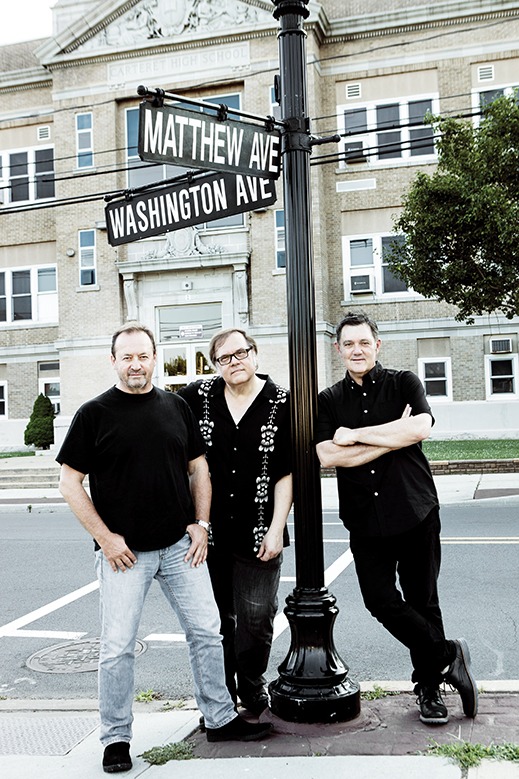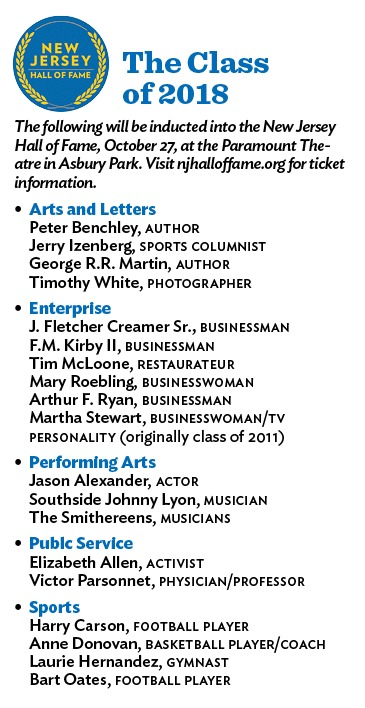
Smithereens, from left, Jim Babjak, Dennis Diken and Mike Mesaros revisit Carteret High School, where their rock’n’roll dreams took root. Photo: Justin Boru
The sign outside the building reads, “Welcome, Smithereens!”
But when bandmates Dennis Diken, Mike Mesaros and Jim Babjak show up on this hot summer afternoon, only a handful of people are assembled. What seems like a rock group’s worst nightmare is instead this trio’s idea of a good time.
The three Smithereens have come for a photo shoot at Carteret High School. As teenagers, the future rock stars had slouched through these locker-lined hallways. Now, Diken, the band’s unofficial archivist, has shown up with a camera slung around his neck. Mesaros launches into an impression of his French teacher: “Let’s go, girls! Find your homeroom!” And Babjak, running late from work at a Jersey City day job he doesn’t like to talk about, is surprised to be greeted by Dennis McFadden, Carteret’s chief of police, who graduated with the threesome in 1975.
After handshakes with McFadden and the school’s current principal, David Salvatore (class of 1978), the men reminisce about underage carousing at Babjak’s Corner, the long-gone tavern once owned by Babjak’s father. “He tossed me out a few times,” McFadden admits.
The Smithereens will celebrate their 40th anniversary next year. Remarkably, they’ve carried on without lead singer Pat DiNizio, who died in December 2017 after a long illness. He was 62. DiNizio was the songwriter behind the band’s best-known 1980s hits, including “A Girl Like You,” “Blood and Roses” and “Only a Memory.”
These days, the Smithereens—who will be inducted this month into the New Jersey Hall of Fame—enlist guest vocalists like Marshall Crenshaw to channel DiNizio’s spirit as frontman for their tours.
“They’re as close as brothers and have forged a musical style amongst themselves, and that’s a powerful thing,” says Crenshaw, who has done more than a dozen live shows as a Smithereen from Tulsa to New York City, and plans to do more.
In a way, the band has come full circle. The Smithereens were formed in 1980, when DiNizio, who was from Scotch Plains, joined the trio of drummer Diken, bassist Mesaros and guitarist Babjak, who all hailed from Carteret. Together, they developed a jangly, 1960s-inspired, garage-pop sound.
Mesaros and Babjak, who shared an accordion teacher as 7-year-olds, grew up almost close enough to Diken to hear him banging on coffee cans in his bedroom. Babjak and Diken found each other freshman year, in 1971. Babjak, sitting one row in front of Diken in earth-science class on the first day of school, appeared to be the answer to Diken’s rock ’n’ roll prayers.
“When I got to high school, I really wanted to form a band,” says Diken, 62. “I thought, Hopefully I’ll meet a musician who’s into the same thing I’m into, which predominantly at that moment was the Who. I thought, If I could meet a kid who could play ‘I Can’t Explain,’ I’ll have met my soul mate.” Babjak, occupying the seat in front of him, had what Diken describes as a Beatle-ish haircut. That was promising. “Then I saw he had Hit Parade pictures of the Who plastered in his notebook.” His suspicion that he had hit the jackpot was confirmed when Babjak, now 61 and living in Monmouth County, said he played guitar.
“We’ve been best friends since that day,” says Diken, who now lives in Bergen County.
Mesaros, 61, has lived in California since 1989. He left the band for almost a dozen years to be a stay-at-home dad to his two daughters before returning to the fold in 2016. Way back in his high-school days, before he started hanging out with Diken and Babjak, Mesaros didn’t know his way around a bass. “They had no bass player, so I got myself a $15 monstrosity, and Jimmy showed me a couple songs in his garage,” says Mesaros. “And I just practiced my butt off.” The songs, he recalls, were “I Can’t Explain” by the Who and “It’s My Life” by the Animals.
The trio migrated after school to Babjak’s garage and laundry room to practice. It was social salvation for Mesaros. “Mike wanted to be in the band with us, so he learned how to play bass,” says Diken. It paid off. Today Diken calls Mesaros “one of the best bass players on the planet.”
There’s a case to be made that all three remain at the top of their games, especially Diken, who also performs with vocalist Ronnie Spector and Dave Davies of the Kinks, one of the bands the young Smithereens obsessed over.
 Dues have been paid, of course. After graduation from Carteret High in 1975, Diken found DiNizio through an ad in the Aquarian Weekly. “It was around 1978 or so,” says Mesaros. “Pat cited Buddy Holly as an influence, so that’s pretty much why Dennis got in touch with him.” If a sound was coming together, a record deal wasn’t.
Dues have been paid, of course. After graduation from Carteret High in 1975, Diken found DiNizio through an ad in the Aquarian Weekly. “It was around 1978 or so,” says Mesaros. “Pat cited Buddy Holly as an influence, so that’s pretty much why Dennis got in touch with him.” If a sound was coming together, a record deal wasn’t.
“We fought so long and hard to get our first deal” with Capitol Records, Mesaros says. “It took five years for us to get signed. Pat was the most persevering person when it came to that. He just had this bullheaded determination.” While they were persevering, the Smithereens released two independent EPs.
By the late 1980s, the band had a few hits and regular airplay on MTV. Their audience grew, and in 1990 the band peaked with their second Capitol release, 11, featuring the top-40 hit “A Girl Like You,” which reached No. 41 on the Billboard albums chart.
Then came more lean years. “We lost our record deal in 1993, and we couldn’t get another one for a long time,” Babjak says. It might have just felt that way. In 1994, RCA signed the Smithereens; that deal was good for one album. By 1999, they had moved on to the independent Koch label to record God Save the Smithereens. “All the while, we never stopped playing,” Babjak says. “Thirty-nine years nonstop.”
“It’s what we do,” Mesaros adds. Even in the midst of heartbreak.
When DiNizio died, the Smithereens were already booked to play the Count Basie Theatre in Red Bank the following month. Diken, Babjak and Mesaros chose not to cancel. Instead, they put on the tribute show, “Time and Time Again: A Celebration of Pat DiNizio,” in association with Steven Van Zandt, who hosted and sang on several songs. Crenshaw also was invited as a guest vocalist. So was Robin Wilson, lead singer of the Gin Blossoms, who later “made it very clear,” Diken says, that he, too, was up for assuming lead-singer duties.
“We never thought we needed to find a soundalike or a lookalike for Pat,” Diken says. “We were just hoping to find a singer who was sympathetic, who could interpret Pat’s songs.” Crenshaw has been the one so far, but Wilson has also done frontman duty at several shows and hopes to do more. “If you had told me as a 19-year-old kid working in a record store in Arizona that I would one day be playing with the Smithereens, I would never have believed it,” says Wilson. “They’re the most authentic band. They’re also the best guys.”
Says Mesaros: “The way it feels when we play now is that we’re keeping Pat’s legacy alive. Those songs came from the depth of his soul. When we play them, I feel Pat’s presence in the room.”
Everyone seems to. Mesaros has to fight tears whenever the band performs “Strangers When We Meet,” a lesser-known 1986 tune. “When we play that song, I’m right back with him at Kenny’s Castaways,” says Mesaros, referring to the legendary Greenwich Village club that, along with the Stone Pony in Asbury Park, the Dirt Club in Bloomfield and Court Tavern in New Brunswick, helped give the band liftoff.
For Diken, it’s still strange to look up while onstage and not see DiNizio in front of him. He tries not to get emotional when the set list includes “I Don’t Want to Lose You,” the first song DiNizio wrote. Babjak misses his onstage rapport with DiNizio: “Before a solo, Pat would sometimes call out, ‘Jimmy!’ with an exclamation point. When we first started playing with Marshall, I kind of lost my place at times because Pat wasn’t there shouting my name.”
Shouting should be expected at the New Jersey Hall of Fame induction ceremony on October 27 in Asbury Park when the Smithereens are called to the stage. In addition to being honored, they’ll play at least a couple of songs. Diken says being in the company of prior inductees like Frank Sinatra, Abbott and Costello, and the Four Seasons is “mind-blowing.” Babjak hopes the recognition will win him the right to avoid taking his shoes off for security at Newark Liberty Airport. And Mesaros expects DiNizio’s spirit to be part of the goings-on. “I think he’ll feel the love in the room for him. I think he feels it on the nights we play,” he says. “Somehow, I know it’s getting through to him.”
RELATED: Jersey’s Enduring Folk-Music Scene



